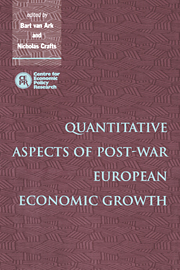Book contents
- Frontmatter
- Contents
- List of figures
- List of tables
- List of contributors
- Preface
- 1 Catch-up, convergence and the sources of post-war European growth: introduction and overview
- 2 Macroeconomic accounts for European countries
- 3 Sectoral growth accounting and structural change in post-war Europe
- 4 Measures of fixed capital stocks in the post-war period: a five-country study
- 5 Technology indicators and economic growth in the European area: some empirical evidence
- 6 Human capital and productivity in manufacturing during the twentieth century: Britain, Germany and the United States
- 7 Convergence and divergence in the European periphery: productivity in Eastern and Southern Europe in retrospect
- 8 Convergence: what the historical record shows
- 9 Growth and convergence in OECD countries: a closer look
- 10 On the historical continuity of the process of economic growth
- 11 Europe's Golden Age: an econometric investigation of changing trend rates of growth
- Index
8 - Convergence: what the historical record shows
Published online by Cambridge University Press: 23 December 2009
- Frontmatter
- Contents
- List of figures
- List of tables
- List of contributors
- Preface
- 1 Catch-up, convergence and the sources of post-war European growth: introduction and overview
- 2 Macroeconomic accounts for European countries
- 3 Sectoral growth accounting and structural change in post-war Europe
- 4 Measures of fixed capital stocks in the post-war period: a five-country study
- 5 Technology indicators and economic growth in the European area: some empirical evidence
- 6 Human capital and productivity in manufacturing during the twentieth century: Britain, Germany and the United States
- 7 Convergence and divergence in the European periphery: productivity in Eastern and Southern Europe in retrospect
- 8 Convergence: what the historical record shows
- 9 Growth and convergence in OECD countries: a closer look
- 10 On the historical continuity of the process of economic growth
- 11 Europe's Golden Age: an econometric investigation of changing trend rates of growth
- Index
Summary
Introduction
In this chapter we provide a survey of the long-run evidence for convergence of productivity levels among the advanced industrialized countries. In addition to work based on Maddison's (1991) well-known national income data we also survey evidence from two other sets of data. Broadberry (1994c) examines labour productivity in manufacturing for twelve countries while Williamson (1991) provides evidence on real wages of unskilled workers for fifteen countries. We argue that the evidence is best seen as consistent with a process of local rather than global convergence, with more than one ‘convergence club’, even amongst the advanced industrial economies. Furthermore, the convergence process has not been smooth or continuous. In short, both geography and history matter.
Definitions
Exogenous and endogenous growth
Underlying the convergence debate is a conflict over the vision of the growth process. The standard neoclassical growth model predicts global convervence of productivity and living standards (Lucas, 1988). Rejection of global convergence thus implies a move away from the model which has dominated economists' thinking about growth in recent decades. Rather than seeing growth as exogenously given by population growth and technical progress and independent of savings and investment as in the standard neoclassical model, in the more recent literature the rate of growth has been endogenized and can be influenced by the accumulation strategy of individuals and governments. The new growth literature has placed a new emphasis on the accumulation of human capital (Lucas, 1988, 1993; Romer, 1990). Learning effects and externalities mean that there is no guarantee of convergence in a world of competitive economies since social and private returns often differ.
- Type
- Chapter
- Information
- Quantitative Aspects of Post-War European Economic Growth , pp. 327 - 346Publisher: Cambridge University PressPrint publication year: 1997
- 1
- Cited by



